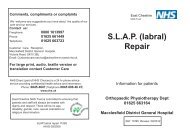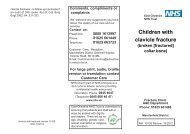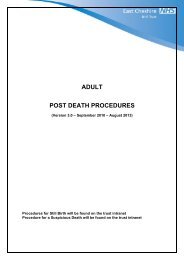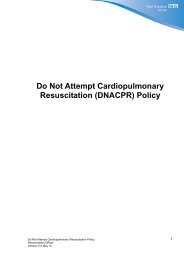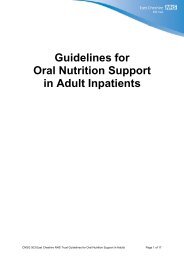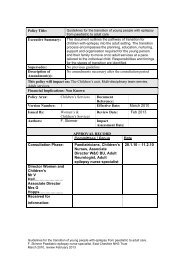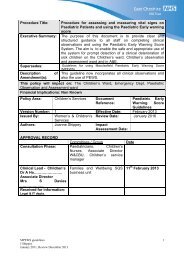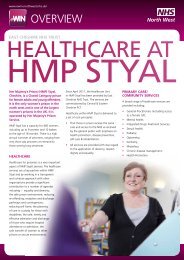Diabetes guidance 1766.pdf - East Cheshire NHS Trust
Diabetes guidance 1766.pdf - East Cheshire NHS Trust
Diabetes guidance 1766.pdf - East Cheshire NHS Trust
Create successful ePaper yourself
Turn your PDF publications into a flip-book with our unique Google optimized e-Paper software.
Glycaemic ControlHbA1c MeasurementHbA1c is the primary test for assessing medium-term glycaemic control. It should usually be measured every6 months and more frequently if glycaemic control is poor. However, HbA1c measurements more often thanevery 2 months are not usually appropriate due to its long half-life.Reporting of HbA1c results in the UK changed on 1st June 2011 following preparation of a new standardfor calibrating HbA1c assays by the International Federation of Clinical Chemistry and Laboratory Medicine(IFCC). Results are now reported in new IFCC units (mmol/mol haemoglobin) only; use of DCCT-alignedtraditional units (%) for reporting results has ceased. The equation relating the new and old units is:DCCT-HbA1c (%) = [IFCC-HbA1c (mmol/mol)/10.93] + 2.15Diabetic subjects should be involved in setting targets for glycaemic control, taking into account side effectsof treatment, effect of the management regimen on quality of life, and risk of hypoglycaemia. Those withhigher HbA1c levels should be informed that any reduction in level towards the agreed target is advantageousto future health.Tight glycaemic control reduces the incidence of microvascular complications.Type 1 (DCCT 1993) Reducing HbA1c from 75 to Reduced retinopathy by 63%54 mmol/mol Hb Reduced albuminuria by 54%Type 2 (UKPDS 1998) Reducing HbA1c from 63 to Reduced retinopathy by 21%53 mmol/mol Hb Reduced albuminuria by 34%NICE <strong>guidance</strong> CG87 (2009) recommends a target of 48 mmol/mol Hb for patients with type 2 diabetes andto avoid pursuing highly intensive management to levels below 48 mmol/mol Hb. Other evidence (ACCORD,NEJM 2008) suggests that the most appropriate HbA1c target is ≤53 mmol/mol Hb.Laboratory tests for the annual diabetes reviewThe core annual review laboratory tests for all patients with diabetes are HbA1c, lipids (preferably fasting),renal profile and urine albumin/creatinine ratio.Other annual review tests are only needed in selected patients, as follows:• Thyroid function tests in Type 1 diabetes; they are not indicated in Type 2 diabetes.• Vitamin B12 (without folate) if on metformin, particularly if there is peripheral neuropathy (but not neededif on B12 replacement).• Liver function tests (LFTs) if on pioglitazone. [LFTs should also be done before starting metformin/statin/fibratetherapy, and 3 / 12 months following statin/fibrate initiation or a change in dose, but not subsequently ifLFTs are then normal.]• Glucose (preferably fasting) in the occasional patient with a variant haemoglobin in whom HbA1c cannotbe determined reliably; it is not indicated in other patients.• Full blood count is not required.





